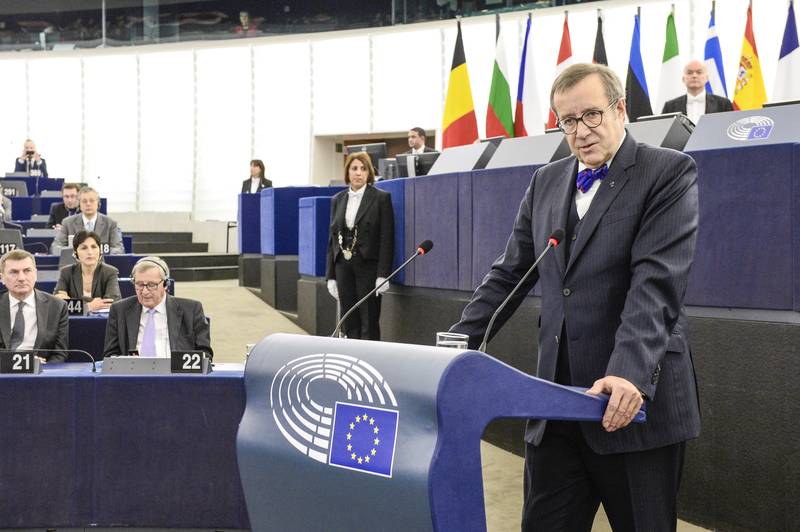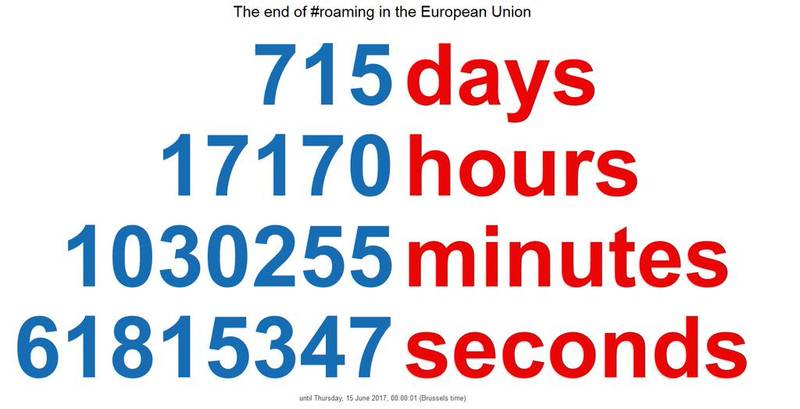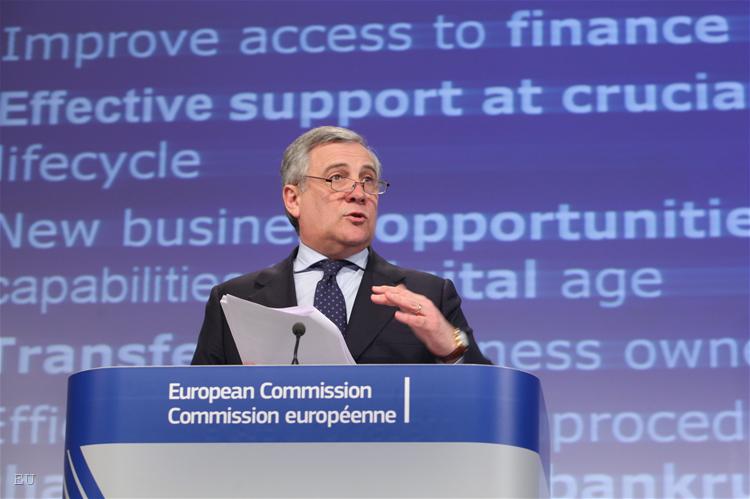20 Years Single Internal Market - Now Where To?
Zhaneta Kuyumdzhieva, trainee, November 5, 2012
 20 years have passed since the idea of a single market in Europe has come into practise. As it should, the anniversary was marked by a variety of initiatives. One of the most important ones was the adoption of the Single Market Act II by the Commission in the beginning of the month. The week of October 15-20 was bristling with related to the topic events in all the member states - workshops, seminars, online quizzes, trade fairs and exhibitions. And, again, as it should, but this time in the spirit of a Europe-wide reconsideration of the EU policies, the celebrations did not avoid being overshadowed by the Europeans' scepticism about "more Europe", "more integration" and, of course, "more single market".
20 years have passed since the idea of a single market in Europe has come into practise. As it should, the anniversary was marked by a variety of initiatives. One of the most important ones was the adoption of the Single Market Act II by the Commission in the beginning of the month. The week of October 15-20 was bristling with related to the topic events in all the member states - workshops, seminars, online quizzes, trade fairs and exhibitions. And, again, as it should, but this time in the spirit of a Europe-wide reconsideration of the EU policies, the celebrations did not avoid being overshadowed by the Europeans' scepticism about "more Europe", "more integration" and, of course, "more single market".
Precisely that reserved attitude toward Brussels could be felt a few days earlier during debates on the issue to what extent does the internal market serve Europe's goals. Initially, the very need of a discussion on the issue was astonishing but then the arguments themselves, which in their essence are justified. So far, the project, initiated in the distant 1992, has indisputable achievements. Until 2008, in the EU 2.77 million additional jobs have been created and the contribution of the single market to the GDP is estimated to be 2.13%. The integrated market has created an opportunity for a bigger choice of products at lower prices, it provided enterprises with an access to 500 million consumers, to broader educational and living perspectives, allowing for the education of 2.5 million students in the past 25 years.
The Single Market Act II adopted by the Commission in the beginning of October, in fact is an expansion of the act from April 2011. The tools in it for ensuring competitive social market economy have to be considered together with the leading initiatives in the Europe 2020 strategy and more specifically the strategy for industrial policy, digital technologies and the Innovation Union initiative. The new document focuses on four key areas with a potential to generate growth:
1. Development of fully integrated networks in the framework of the single market (in the area of energy);
2. Boosting the trans border mobility of citizens and enterprises;
3. Support for the digital economy across Europe;
4. Enhancing social entrepreneurship, convergence and security of consumers.
In spite of the explicit benefits so far and the estimated future benefits from the overall implementation of the directives under the Single Market Act I and its supplement, confidence in the project seems to be fading, judging from the debates broadcast live on the YouTube and Google+ on October 10th. In the debate, opinions clashed a diplomat, two university professors and a political scientist. The opinion of Prof. Victoria Curzon from the University in Geneva was intriguing, who said that the problem of the single market was the method of harmonisation. She believes that unless there are equal conditions at the start free trade will not be fair. Harmonisation, meaning putting up standards that need to be precise and high, will deprive businesses in less developed countries of advantages because they will be unable to respond to those requirements.
Therefore, this would create hurdles for the most effective firms, thus slowing growth down, instead of accelerating it. Against the internal market spoke Dr. Andre  Crowell, a leading political scientist and Professor with the University of Amsterdam, who said that the barriers Act I and Act II aim to remove will in fact shield consumers from market forces and that this project is not a solution to the growing unemployment and the social needs of the citizens. The presence and arguments of the defenders of the internal single market were no less intriguing. According to David Hannay, an English politician, former permanent representative of Britain in the EU (1985-1990), every growth strategy has to include an aspect of "more single market" precisely because of the problems in the eurozone.
Crowell, a leading political scientist and Professor with the University of Amsterdam, who said that the barriers Act I and Act II aim to remove will in fact shield consumers from market forces and that this project is not a solution to the growing unemployment and the social needs of the citizens. The presence and arguments of the defenders of the internal single market were no less intriguing. According to David Hannay, an English politician, former permanent representative of Britain in the EU (1985-1990), every growth strategy has to include an aspect of "more single market" precisely because of the problems in the eurozone.
The example he supported was that part of the measures by the Commission, the ECB and the IMF for the countries that suffered the most from the crisis - Greece, Portugal, Spain, Ireland, Italy - to a large extent contain a recommendation to remove the hurdles for implementation of the single market. The elimination of barriers would be essential for achieving competitiveness in the above mentioned countries. Prof. Sarkar, professor of management in the Evora University, Portugal, highlighted another key advantage of the single market - its role for development of innovation. With the implementation of the directives of Act I and Act II, a change will be secured of the regulations that exist from the time before the digital era and that would develop businesses and entrepreneurship and would lead to creation of more jobs. He quoted a research by the McKinsey institute from May 2011 which says that 20% of the developed countries' growth in the last five years stemmed from the Internet.
Support for the digital economy in Europe
It is the digital economy that is one of the four areas with potential for development that is highlighted in the new Single Market Act. In this area the EU aims to enhance the citizens' confidence in online services by improving the market of online payments. Another task is reducing spending and increasing effectiveness of broadband communication infrastructure. A 10% increase of spreading of broadband Internet could  lead to GDP growth of up to 1.0-1.5% annually and to 1.5% increase of profits from productivity.
lead to GDP growth of up to 1.0-1.5% annually and to 1.5% increase of profits from productivity.
And last but not least, optimisation of resources in the public sector, the description of which strongly reminds the English saying that a penny saved is a penny earned. The idea for a paperless administration and e-invoicing would significantly contribute to saving. Preliminary assessments show that in several years the adoption of that type of invoicing would save almost 1 billion euros per year.
Creating a single energy and transport market
Other ways to achieve growth the document proposes in addition to the first Act, are related to the transport and the energy industry. The possibility passenger transport on internal railways to be checked by external operators would improve quality, prices and efficiency of such a type of services. In the area of maritime transport (with which some 40% of goods all over the EU is realised), administrative alleviation is  foreseen in terms of ports. Estimations about air transportation show that passengers, air companies and the economies of the Union in general would save 5 billion euros if the not very productive so far project "Single European Sky" is implemented. In this regard, in the beginning of October, Siim Kallas, EU transport commissioner, announced his intention to present new legislative proposals in the spring of 2013, aimed at accelerating the implementation of the initiative.
foreseen in terms of ports. Estimations about air transportation show that passengers, air companies and the economies of the Union in general would save 5 billion euros if the not very productive so far project "Single European Sky" is implemented. In this regard, in the beginning of October, Siim Kallas, EU transport commissioner, announced his intention to present new legislative proposals in the spring of 2013, aimed at accelerating the implementation of the initiative.
The energy sector could be even more saving if the third energy package is implemented adequately. Calculations show that the EU would save some 13 billion euros per year through the advantages in the sector and reducing the end-prices for consumers. The next area in which the Single Market Act II foresees actions is consumer protection. It is expected the Commission to propose a legislative and non-legislative package of measures aimed at creating a more homogeneous single market for the consumers for products that respond to the standards and for better protection of health, safety and environment. It will also decrease the spending of enterprises to abide with the requirements and would help remove unfair competition by unscrupulous operators, especially through better coordination of safety checks for the products on the EU external borders.
 Apart from dealing with the obstacles for consumption of goods, work is envisaged on improving the conditions for financial services by the citizens and businesses. The existing motives for discrimination in that sense, like refusing to open a bank account because of nationality or lack of permanent address in a member state, together with unclear information about banking tariffs that prevents citizens from exercising their right of informative choice, gave the Commission a reason to introduce additional legislative proposals to facilitate access to financial services, thus ensuring that consumers have unhindered way of participation in the social-economic activities.
Apart from dealing with the obstacles for consumption of goods, work is envisaged on improving the conditions for financial services by the citizens and businesses. The existing motives for discrimination in that sense, like refusing to open a bank account because of nationality or lack of permanent address in a member state, together with unclear information about banking tariffs that prevents citizens from exercising their right of informative choice, gave the Commission a reason to introduce additional legislative proposals to facilitate access to financial services, thus ensuring that consumers have unhindered way of participation in the social-economic activities.
In the initiative for social entrepreneurship from October 2011, the Commission proposed an Action Plan for increasing the role of social entrepreneurship in the framework of the single market, as was pointed out in the first Act of April 2011 and in the beginning of 2014, a review will be made on the progress made and additional actions in this area will be discussed.
Boosting citizens' transborder mobility
Key actions are planned for improving the opportunities for financing and long-term investments in the economy. As a result of the crisis, financial aid for companies and investments has declined by 45% which significantly restricts the money for businesses. In order to turn the negative statistics upside down, special focus will be put on the European financial instruments and forms for long-term investment funds, as well as possibility the member states to benefit from the structural funds to improve the access to funding of the small and medium-sized enterprises.
Where are we with the directives?
Although the completion of the single market seems ever far away and the crisis is slowing additionally down its completion by creating a need for it to be supplemented,  the results from the review of the transposition of directives are relatively good. In terms of application of the EU legislation, the number of violations is diminishing. It is supposed that the positive trend here is influenced by the earlier introduced mechanisms to overcome discrepancies. The average deficit among the 27 member states in transposing directives has declined from 1.2% to 0.9% in the past six months and the number of countries that have achieved the goal of 1% has increased from 11 to 16. The total number of cases of infringements related to the internal market is also dropping - 37% less compared to 2007. Nonetheless, usually the deadline to remove the established by the Court of Justice of the EU irregularities is still quite long - on average 17.5 months and for some countries even over two years.
the results from the review of the transposition of directives are relatively good. In terms of application of the EU legislation, the number of violations is diminishing. It is supposed that the positive trend here is influenced by the earlier introduced mechanisms to overcome discrepancies. The average deficit among the 27 member states in transposing directives has declined from 1.2% to 0.9% in the past six months and the number of countries that have achieved the goal of 1% has increased from 11 to 16. The total number of cases of infringements related to the internal market is also dropping - 37% less compared to 2007. Nonetheless, usually the deadline to remove the established by the Court of Justice of the EU irregularities is still quite long - on average 17.5 months and for some countries even over two years.
With the communication for the new Act, the Commission calls on the member states to cooperate for fast elimination of infringements and invites them to prioritise the transposition of the directives related to the Single Market Act II, focusing in the same time on the potential of the areas enshrined in it for jobs creation and economic growth - the most urgent goals of the EU at the moment.
 Toomas Hendrik Ilves | © European Parliament
Toomas Hendrik Ilves | © European Parliament | © European Commission
| © European Commission | © EU
| © EU